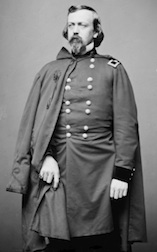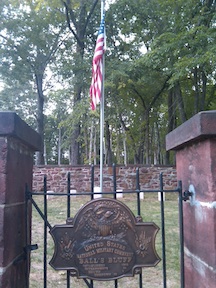One of the Smallest–and Most Significant–Battles of the War

Once bodies started floating down the Potomac past Washington, it was tough for officials in the capital to overlook the battle at Ball’s Bluff.
It was bad enough that the Union forces there had been soundly trounced. Of the 1,700 or so Federals engaged, more than a thousand ended up as casualties: 223 killed, 226 wounded, and 553 captured. Among those killed: Colonel Edward Baker, commander of Union forces on the field.
And that was the problem. Baker was a lifelong friend of President Lincoln’s. They were so close, the Lincolns had named their second son Edward Baker Lincoln. Beyond that, Baker was also a sitting member of the U.S. Senate, representing Oregon. To this day, Baker remains the only serving member of the Senate to be killed during battle.

So perhaps the disaster along the steep riverbank just north of Leesburg, Virginia, could’ve been overlooked—after all, who wanted to pay attention to another Northern defeat so soon after Manassas—but Baker’s death made the defeat politically hypercharged.
The bodies floating down the river, past the nation’s capital, didn’t help either.
The battle, which took place on October 21, 1861, was otherwise a minor affair. Brigadier General Charles Stone, acting on faulty intelligence, sent a raiding party across the river north of Leesburg even as Confederates were moving into that very same area.
As historian James A. Morgan III has said, it was a recipe for disaster almost from the beginning. “In the pre-dawn house of October 21, [Colonel] Charles Devens was not a happy man,” Morgan writes in his battle study A Little Short on Boats. “He had been ordered to lead his first combat mission on virtually no notice, with 300 green troops, at night, across a swollen and swiftly running river, into an area about which he had little information, and he had to get started immediately.”
Devens stumbled into trouble, and as the situation escalated and more troops from both sides funneled into the battle, Stone ordered Baker to take command on the field. By all accounts, he didn’t seem to do such a hot job, and ultimately Confederates overran the Union position, killing Baker in the process. The Federal army didn’t have enough boats to mount an effective escape, so Union survivors, pinned against the river, had to swim the gauntlet to safety, try to mount a resistance, or end up as captives.
For Confederates, it was like shooting fish in a barrel.
North and South had been evenly matched: about 1,700 troops on each side. Otherwise, the story of the battle features all the hallmarks of the early war: nonstandard uniforms that led to confusion on both sides, inexperienced troops and officers trying to make sense of the fog of war, and, yes, even a guest appearance via telegraph of a George B. McClellan infected with “the slows.”

Stone would be the fall guy for the disaster at Ball’s Bluff. After all, Baker was dead, and someone had to take the blame. The Joint Committee on the Conduct of the War, formed in the wake of the battle, ran Stone through a kangaroo court and imprisoned him without formal charges for months. It was an amazing turn of fortune for an officer who had served with distinction in the Mexican War and had recently been in charge of Lincoln’s personal security. Former army chief Winfield Scott, when he heard about Stone’s arrest, proclaimed, “If he is a traitor I am a traitor, and we are all traitors.” Another officer, Lt. Col. Isaac Wistar, a friend of Baker’s, echoed the sentiment: “If General Stone is a traitor, there are no true men.”
Even the newspapers, which were no fans of Stone because he drummed several reporters out of his camps earlier in the war, eventually took up his case. “General Stone has sustained a most flagrant wrong,” wrote The New York Times, “a wrong which will probably stand as the very worst blot on the National side in the history of the war.”
After six months, Stone was released, and although he was cleared, his reputation remained tarnished. He returned to service under Nathaniel Banks as chief of staff during the Red River campaign. Following the war, he served with distinction in the Egyptian army, and later, back in the U.S., he supervised the construction of the Statue of Liberty’s pedestal.
It may be Stone, not Baker, was the most significant casualty of Ball’s Bluff. After all, if the Joint Committee could railroad a competent officer like Stone, what could happen to other officers who tried to do their duty? Suddenly, everyone in the Union army was looking over their shoulder because, somewhere, the Joint Committee was looking over their shoulders, too.
 Today, Ball’s Bluff is a regional battlefield park operated by the Northern Virginia Regional Parks Association. A restoration project begun in 2004, which is still ongoing, has returned much of the battlefield to its wartime appearance. An interpretive trail with excellent signage winds through the 12-acre park and goes all the way down the bluff’s steep slope to the riverbank. Ball’s Bluff National Cemetery—the third-smallest in the nation—contains fifty-four Union soldiers buried in twenty-five graves; all but one are unknown.
Today, Ball’s Bluff is a regional battlefield park operated by the Northern Virginia Regional Parks Association. A restoration project begun in 2004, which is still ongoing, has returned much of the battlefield to its wartime appearance. An interpretive trail with excellent signage winds through the 12-acre park and goes all the way down the bluff’s steep slope to the riverbank. Ball’s Bluff National Cemetery—the third-smallest in the nation—contains fifty-four Union soldiers buried in twenty-five graves; all but one are unknown.
While visitation at the battlefield continues to be steady, the battle remains largely forgotten or, at best, overlooked as a minor skirmish. However, the repercussions of the battle could not have been more monumental. The political shadow cast by the Committee over the army would, in truth, turn into a shroud of overcaution that would severely hamper the Northern war effort until the conflict’s end.
Even now, it’s tough to overlook that.
Great little battlefield. Sad that it is tucked away behind one of the many housing plans of the area. It really has long reaching implications.The Committee on the Conduct of the War is born out of this mess. So many officers lost their careers because of the committee.
Great stuff.
We received the following comment from a Civil War forum over the weekend about this post: “Good story, excellent writing style, but kind of a bummer that all Confederates, and all Federals but three men, were nameless, stateless, and regimentless. More for the casual reader than the Civil War buff. We wanna know who.”
We thought we’d pass this along as a way to let you know that we’ll have more about Ball’s Bluff coming up as we get closer to the anniversary of the battle. So, don’t fret—this is only part of the story. In the meantime, for anyone looking for a microtactical study of the battle, we highly recommend James A. Morgan’s excellent A Little Short of Boats. More about that book coming up as our coverage of Balls’ Bluff continues!